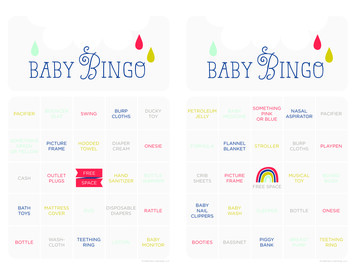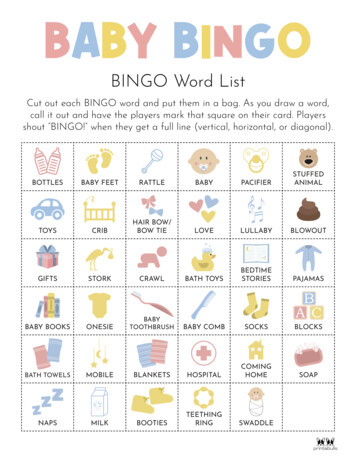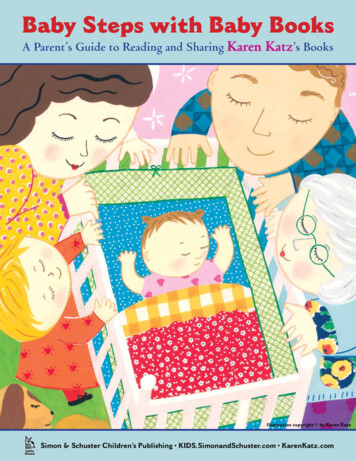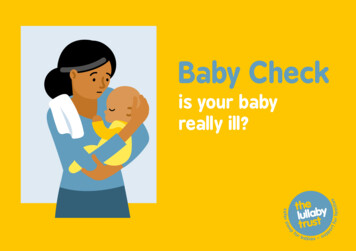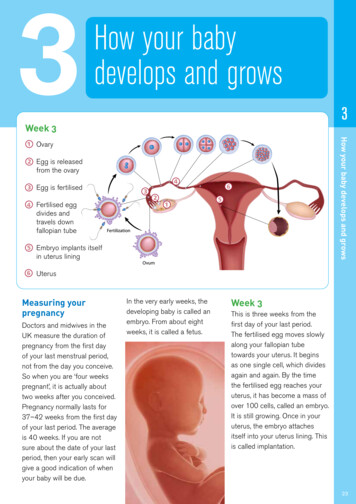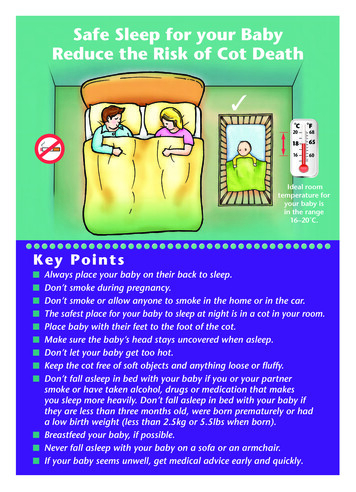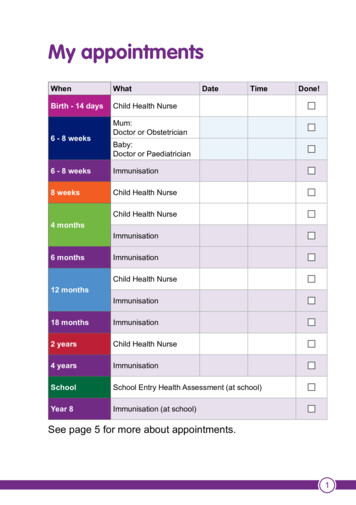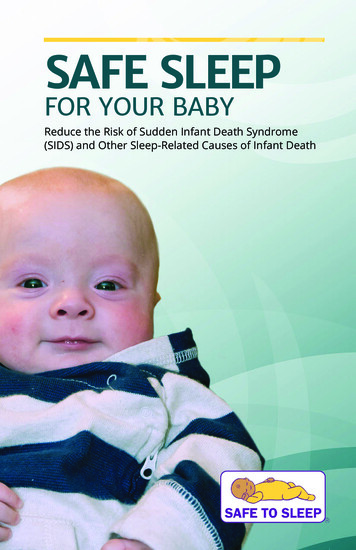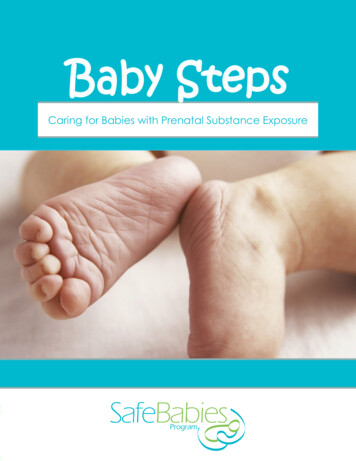
Transcription
Baby StepsCaring for Babies with Prenatal Substance Exposure
baby stepscaring for babies with prenatal substance exposureMinistry of Children and Family DevelopmentVancouver RegionIn partnership with:Ministry of Children and Family DevelopmentVancouver Coastal HealthVancouver Aboriginal Child & Family Services Society
acknowledgementsThe 1st Edition of this guidebook was produced as: Safe Babies: A caregivers guideto daily care for infants exposed prenatally to alcohol and drugs (2000). LenoraMarcellus (Ed.), BC MCFD.Copyright status: reproduction of this material is permitted for teaching purposes.Citation of the source is appreciated.2nd Edition updated December 2003Ministry of Children and Family Development (MCFD), Vancouver Coastal Health,and Fraser Health, British ColumbiaRadhika Bhagat, MN, RN, & Pam Munro, MSN, RN3rd Edition updated August 2011Charlotte Nelson, BSN, RN; Radhika Bhagat, MN, RN; Kate Browning, BSN, RN, LeslieMills, BSN, RN; Ministry of Children and Family Development (MCFD)Review and Contributions: Foster Parents: Vancouver Coastal Safe Babies Advisory Committee Infant Development Program: Bonnie Barnes, IDP Consultant, Vancouver; LynnRogers, Physiotherapist Consultant Ministry of Children and Family Development, Coast Fraser Region:Lyna Kiviste, Resources Team Leader, Sandi Karmel, Resources Social Worker Vancouver Coastal Health Authority: Sarah Payne, Sheway Program;Barbara Crocker, Community Nutritionist; Tana Wyman, Dental Program Coordinator; Marianne McCormick, Audiology Program Coordinator; Tamsin Morgana,RN, Regional Immunization Leader; Kelly Yu, RN Educator, Infection Preventionand Control Dr. Lenora Marcellus, PhD, RN, University of Victoria School of NursingPhotos: Charlotte NelsonDesign and Format: Erin GuiltenaneMinor Revisions September 2014Madeline Rigg, BSN, RN, Safe Babies Coordinator, Vancouver Coastal HealthI
using this bookletusing this bookletThis booklet is a resource for parents and caregivers of babies who havebeen prenatally exposed to alcohol or other drugs. Information in this booklet was gathered from various sources, including parents, caregivers,professionals and published books and articles.The information in this booklet is about the daily care of babies aged birthto 12 months who may have been exposed to substances in the womb.Detailed information on topics such as fetal alcohol syndrome, the longterm effects of substance exposure on the growing child, or the care ofbabies with special medical needs (such as oxygen therapy and tubefeedings) is not covered in this resource.disclaimerThe information in this booklet should not replace the advice given by ahealth professional (such as the baby’s doctor).II
prefacecaring for babies with prenatal substance exposureCaring for babies who have been prenatally exposed to substancesrequires knowing more than just “baby care”.Caring for babies who have been prenatally exposed to substances requires: An understanding that other than alcohol and drugs, things like the mother’shealth, stress level, and nutrition impacts how a baby grows in the womb An understanding of the importance of preserving the parent-babyrelationship, the baby’s cultural heritage, and family and communityconnections An understanding of the importance of infant attachment An ability to make a special connection to a baby An understanding about how to listen to babies and respond to their needs Caregiving strategies and “tools” for challenging times An ability to recognize problems with growth and development early on sothat help can be received as soon as possible Knowledge about how to access community resources that assist and support caregivers and babies Recognizing that each individual infant is unique.The authors of Baby Steps wish to express their heartfelt thanksto Jamie, birth mother, and to Tina, foster parent, for sharingtheir experiences with us.III
prefaceJamie’s storyWhen I was asked to write something that was to be included in this guide,I wasn’t sure I had anything to offer. After all, I am not a professional andmost of the time I feel like I don’t have a clue what I am doing!Being a parent is the hardest job anyone will ever have and in my case perhaps even harder because my child was born addicted. The guilt I live withis at times completely overwhelming, but for my son’s sake I must find away to make the best of things. I do that every day by staying clean andsober.As I thought about what to write, I realized that I do have a message toconvey. The message is simple: having my baby was the best thing that ever happened to me. It didn’t seem that way at first, but I have come to believe that he was sent to me for a reason – to save my life. When he wasborn I was given a reason to live. It was the most difficult thing I have everdone to stop using drugs, and lots of times I wanted to give up. I had a lotof help along my journey to recovering and all I had to do was ask.My son is five years old and he is so beautiful that at times I look at him andI just start to cry. I thank God everyday for the life I have and I know it’sbecause of my son.If you are about to begin this journey I urge you to ask for help and say aprayer. If you are willing, this could be the best thing that ever happened toyou and you are in for the ride of your life. God bless you.III
prefaceTina’s storyI am a foster parent. I have the ability to love and nurture other women’sbabies.These are not ordinary babies with ordinary problems. I must always remember that every child is first a child; everything else is secondary. I must alsolove and nurture the child within the body. I will persist and insist that weconnect at a deeper level than the physical. I know that with time andpatience the sound of my voice, the touch of my hand, and the beating ofmy heart will become their soothing balm. They will respond to me, each intheir own unique way. Only when we have connected can we move forward together on our journey to explore the world.Over the years these babies have enriched my life and given me manyopportunities to learn. I have learned to recognize the miracle of their birth.I have learned to celebrate our differences. I have learned to have a deeprespect and appreciation for the power of the life force surging throughtheir little bodies. I have learned to see perfection in imperfection. I havelearned to see them as survivors rather than victims.I have also learned to let go and trust thateach little person must find his or her ownway through the life experience. I havelearned to allow myself to grieve deeply andfully for each little child that leaves my care.I have learned that I, too, am a survivor.I am a foster parent.III
table of contentstable of contents1AcknowledgementsIUsing this bookletIIPrefaceIIITable of contentsIVCHAPTER 1 - SUBSTANCE USE IN PREGNANCY1Effects of substance use on the babyPremature birth3Short-term effects4Long-term effects6Common substances of concern8Tobacco9Alcohol9Opiates10Cocaine and crack11Marijuana (cannabis)11Amphetamines and methamphetamine12Inhalants and solvents12The benefits of a stable and loving home22CHAPTER 2 - SOCIAL & EMOTIONAL DEVELOPMENTHelping babies form a secure attachmentTemperament13141417IV
table of contents34CHAPTER 3 - INFANT SLEEPSigns that baby is tired18Normal sleep patterns19Effects of prenatal exposure on sleep20Helping babies sleep20What does not work to promote sleep22Persistent sleep problems22Sleep position: reducing the risk of SIDS23What you can do to prevent SIDS24CHAPTER 4 - INFANT CRYING26Normal crying behaviour26Helping babies comfort themselves27When babies cry a lot28Comforting techniques (pictures)Shaken baby syndrome and abusive head trauma5183132CHAPTER 5 - INFANT FEEDING34Normal feeding patterns34Breastfeeding35Formula feeding37When babies don’t feed well39Helping the baby to suck and feed40Bottle feeding.helping the feeding muscles(pictures)42Helping the baby who spits up43Gassiness or intolerance45Introducing solid foods47IV
table of contents6CHAPTER 6 - INFANT DEVELOPMENTGrowth and development milestones49Vision50Hearing50Speech and language51Reflexes and muscle tone52Muscle tone53Signs of stress54Encouraging infant development55Positions to encourage flexion (pictures)748CHAPTER 7 - INFANT HEALTH & ILLNESS CARE5758Reducing the risk of infection58Routine practices58Immunizations59Infectious diseases61Dental care64Teething65Caring for the baby who is ill66Fever67Breathing stipation72Skin breakdown74Candida (yeast) infections75Eczema76IV
table of contents78CHAPTER 7 - INFANT HEALTH & ILLNESS CARE CONT’D.Seizures77Giving medication for infant illness78CHAPTER 8 - BRINGING BABY HOMEGetting your home preparedSafety considerations in your homeBringing the baby homeThe baby’s first few weeks at homeCommunity y agencies89Bibliography90IV
chapter 1substance use in pregnancyAlthough alcohol, tobacco, and many other drugs have been in commonuse for centuries, people throughout the world continue to debate aboutthe safety of using these substances during pregnancy. Many years ago, itwas believed that the placenta protected the baby from harmful substances. We now know that the placenta is not a perfect barrier. Alcohol,street drugs, and most medications pass easily through the placenta to thebaby. In the 1970s and 1980s, the prenatal effects of substances such asheroin, cocaine, and alcohol became of great interest to the medicalcommunity, the media, and the general public. Today, we are seeing thesame interest turned to newer street drugs such as crystal meth. Althoughwe are learning more about the impact of substance use in pregnancythere is still a lot of misinformation about this serious health issue, and muchthat we still do not know.Today we know that: Alcohol and substance misuse is a complex issue. Women who misusesubstances often struggle with poverty, homelessness, mental illness,violence, trauma, ill health, and have often experienced abuse anda lack of support and protection from an early age. Women from allsocial and economic groups may use substances while pregnant.However, women who are poor or visible minorities are more likely tobe identified when using substances while pregnant. Alcohol and substance misuse has a biological and genetic component. Some people are more likely to develop a dependence oraddiction after first using alcohol or drugs. Although some babies who are prenatally exposed to alcohol andsubstances will show effects of this exposure, many are born healthy.Also, babies who initially show effects from prenatal substance exposure may not later on as children or adults. Newborn behaviours that cause concern for caregivers may or maynot be related to substance exposure.Continued on page 2.1
substance use in pregnancyContinued from page 1. All babies are different and each will respond in a unique way tocaregiving techniques.Research shows that both nature (the baby’s genetic or biologicalmake-up) and nurture (the environment in which a baby lives andgrows) are important influences on child development.Effective care for babies who have been exposed to substances in thewomb requires communication and teamwork between well-informedparents or caregivers, families, and professionals.effects of substance use on the babyPrenatal substance use may cause premature birth, as well as short-termand long-term effects on the baby. The effects of substance exposuredepends on: The mother’s general health and biological makeupThe mother’s life circumstances, including her level of stress, safety,nutrition, and access to medical careThe amount of drug that was used by the motherThe number and combination of drugs used. It is certain that the useof multiple substances in pregnancy (“polysubstance use”) has a morenegative effect than use of one substance alone (unless that substance is alcohol)When and how often in the pregnancy these drugs were usedThe health and biological makeup of the fetus.The type of drug or drugs used is also a factor to consider when discussingthe possible effects of prenatal substance exposure. One way of talkingabout different substances is based on the type of effects that they mayhave. Substances that are known to cause birth defects are calledteratogens (generally, illegal drugs are not among these substances). Stimulants are substances that “speed up” the body’s central nervoussystem, while depressants are those that slow it down.2
substance use in pregnancypremature birthYou may hear many medical terms that describe the baby at birth. Thisdescription can be how long the baby lived in the mother’s womb(gestational age) or according to the baby’s size or weight. A full-term baby is said to have a gestational age of 40 weeks. The premature (pre-term)baby is born before the 37th week of pregnancy.Terms used to describe the differences in a baby’s weight and size at birthinclude: Low birth weight (LBW): this means a baby is under 2500 grams or 5 ½pounds Small for gestational age (SGA): this means the baby at birth is not asbig as would be expected for his age Intrauterine growth restriction (IUGR): this means the baby is growingvery slowly in the womb for some known or unknown reason Some infants may be both premature and low birth weight.Often, premature babies weigh less than 2500 grams. Babies born prematurely may have organ systems that are not quite ready for the outsideworld. The earlier babies are born, the more help they will need in hospitalto survive and grow. Their brains and muscles (neuromuscular system), theirlungs (respiratory system), their stomachs and guts (gastrointestinal system),their immune systems (for fighting infections), and their overall weight andbody fat may not be developed adequately.After birth, these babies may experience: Breathing problems Feeding problems, such as uncoordinated sucking and swallowing,and digestive problems Slow growth Tiring easily, which can affect feeding and breathing Difficulty in keeping warm (maintaining body temperature) Increased pressure and/or bleeding in the brain Side-effects from medical procedures and treatmentsIn addition, many of these babies spend several days or weeks in a busyand often over-stimulating Neonatal Intensive Care nursery (NICU), whichcan affect their nervous systems. With multiple caregivers they may not receive holding or cuddling from one ‘regular’ caregiver.3
substance use in pregnancyshort-term effectswithdrawalWithdrawal symptoms (formerly called Neonatal Abstinence Syndrome orNAS) that may be seen in the newborn are caused by the mother’s use ofdepressant drugs, which slow down the body’s central nervous system.These drugs are: a group called opiates (such as heroin, methadone, morphine and codeine), alcohol, nicotine, and prescription medications forpain, anxiety or sleep. Any of these drugs may cause neonatal withdrawal(withdrawal experienced by a newborn after birth). Opiate drugs are thosethat most commonly cause neonatal withdrawal requiring medical treatment. However, not all babies exposed to opiates experience withdrawal,and not all require medical treatment for it. Babies do better when themother is allowed to cuddle and hold her baby and have the baby withher in the room.If withdrawal occurs, the symptoms will be seen in the newborn within thefirst few days of life. Exactly when the symptoms begin depends on howwell the baby’s liver works, how long it takes for the particular opiate toleave the body, how much opiate was used, and when it was last used. Ingeneral, heroin withdrawal will be seen within 1 to 3 days, whereas methadone withdrawal can begin 3-4 days after birth. If the baby is experiencingintense withdrawal symptoms, she may be given a medication such asmorphine for a short period of time. Other tests may be done to be surethere is no other reason for these symptoms. The infant should not be discharged from hospital until at least 5 days after their final dose of morphine.4
substance use in pregnancycommon withdrawal symptomsWITHDRAWwakefulness; problems with waking/sleepingirritability; difficulty self-calming and hard to comfort; highpitched crytremors, twitchinghypertonia (stiff muscles); hyperactive reflexes (exaggeratedstartle reflex); high-pitched crydiarrhea; diaphoresis (sweating); disorganized suck/swallowregurgitation (vomiting); poor or weak suck, or frantic suckapnea (stops breathing)weight loss; failure to gain weightother short-term symptomsAfter 6 weeks, some babies may show symptoms such as tremors, poorfeeding and problems with digestion (the “gassy baby”), poor sleep, highor low muscle tone (stiff or floppy muscles), irritability, and high-pitched cry.This is not withdrawal as describedabove, and is not treated withmorphine. Some experts say thesesymptoms are due to the directeffect of some substances on thegrowing brain. It is a good idea tolet the doctor know about thesesymptoms, as she may want to dosome additional medical testing.These symptoms usually improveas the baby gets older and thebrain matures. Most caregiversnotice that babies usually outgrow these symptoms from 4 to 12months of age.5
substance use in pregnancylong-term effectsbirth defects (“teratogenesis”)A teratogen is a substance that interferes with the normal growth of the fetuscausing one or more abnormalities such as damage to the brain, heart,kidneys, and face (as seen with cleft lip and palate).Alcohol is a known teratogen.fetal alcohol spectrum disorder (FASD)FASD is used to describe a variety of effects resulting from exposure to alcoholduring pregnancy. Alcohol exposure can cause facial abnormalities, growthdeficiencies, and hearing or vision impairments. It can also affect learning,behavior, sleep, social and cognitive skills, and mental health. Babies neveroutgrow FASD.Included under the diagnosis of FASD are: Fetal Alcohol Syndrome (FAS),Partial Fetal Alcohol Syndrome (pFAS), and Alcohol-Related Neurodevelopmental Disorder (ARND).fetal alcohol syndrome (FAS)FAS is a medical diagnosis. FAS is easier to diagnose than pFAS and ARND.A diagnosis of FAS is made based on a confirmed or unknown history of themother drinking alcohol during pregnancy, and the following 3 criteria: A pattern of facial abnormalities, including small eye openings, flatmidface, flattened groove between nose and upper lip, and a thin upperlipLow birth weight and slow growth rate throughout childhood, and smallphysical size continuing into adulthoodDamage to the brain, including small head size, structural abnormalities,neurological problems, and behavioral and learning problems. Prenatalalcohol exposure is thought to be responsible for about half of all diagnoses of mental retardation6
substance use in pregnancypartial FAS (pFAS) & alcohol-relatedneurodevelopmental disorder (ARND) pFAS diagnosis requires some of the facial features and growthdeficiencies (as seen with FAS), some evidence of brain impairment,and prenatal exposure to alcohol.ARND diagnosis means that there is a history of maternal alcohol useand evidence of brain impairment — without the associated facialfeatures or growth problems.pFAS and ARND are not necessarily milder forms of FAS. The delaysmay be just as severe as in FAS.Alcohol exposure does not have the same impact on every infant andthere are many factors that can affect the fetus. It is important to remember that each baby is an individual and they may be affected differently.growth & developmental delaySome babies who have been exposed to substances in the prenatalperiod experience long-term effects on their overall growth and development. This includes learning disabilities that affect speaking and understanding, learning and remembering, paying attention for periods of time,and playing with or relating to others.other health risksOther health risks include: Sudden Infant Death Syndrome (SIDS or crib death)Failure-to-thrive (slower than normal weight gain)Infectious diseases, including Hepatitis B and C, HIV, methicillin-resistantStaphylococcus aureus (MRSA), and Syphilis, if mother tested positivefor these infections while pregnantVision and hearing difficultiesBreathing problemsShaken Baby Syndrome or Abusive Head Trauma.7
substance use in pregnancycommon substances of concernIt is difficult to pinpoint the effects of individual substances on the developing baby for the following reasons: Women who use alcohol and other substances frequently use morethan one substance (“polysubstance use”). Poverty, poor diet, abuse, and stress experienced by the pregnantmother may also affect the growing fetus. Physical and mental illness inpregnancy—and medications taken to treat them—may also have aneffect. Pregnant women who smoke cigarettes and/or misuse alcohol andother substances often feel guilty and ashamed and may not want toadmit to their substance use. Each person absorbs and metabolizes substances differently Research evidence on the short and long-term effects of various substances used during pregnancy remains incomplete, and this kind ofresearch is difficult to do. New discoveries in brain science tell us that the human brain is“plastic” (able to be shaped and to change) throughout our lives, andespecially in our early years. For these reasons, the effects of prenatalsubstance exposure are truly unknown for each infant at birth. Thepersonal outcome later in life for any infant born—prenatally exposedor not—will depend significantly on the environment, care, andeducation of that individual.8
substance use in pregnancytobaccoTobacco use, or exposure to second-hand smoke, in pregnancy does notcause birth defects. It can damage blood vessels in the placenta leadingto miscarriage and premature birth. Less oxygen is carried in the bloodwhen cigarettes are smoked, so babies may be born smaller (but still ableto “catch up” in their growth). They are also at increased risk of SIDS, earinfections, bronchitis, and pneumonia, even if there is no cigarette smoke intheir environment after birth. In the immediate period after birth, there maybe signs and symptoms of withdrawal from nicotine. There is evidence thatuse of nicotine in pregnancy increases the symptoms of withdrawal in thebaby. Women who use alcohol and other substances often smoke as well.Some evidence suggests that physical effects later in life may includeobesity, type II diabetes, smaller lung size, respiratory problems, and greatersensitivity to carbon dioxide.alcoholAlcohol can cause birth defects and other long-lasting developmentalproblems (see Long-Term Effects section of this chapter). The effects ofalcohol on the growth and development of the fetal brain are consideredpermanent and irreversible. In the early hours after birth, some babies mayexperience acute intoxication from recent alcohol exposure, and possiblewithdrawal in cases of chronic use. Babies may be jittery, experience feeding and sleeping problems, show low muscle tone (“floppy”), and be sensitive to noise or touch.awareness in actionIt is important to remember thatalcohol causes more harm tothe baby than probably all otherdrugs combined.Alcohol is a legal and accessibledrug and its use is accepted bysociety.9
substance use in pregnancyopiatesOpiates are drugs that are made from the poppy plant. These include opium and heroin, and medications prescribed for pain control (such as codeine, morphine, Dilaudid, OxyContin, and Demerol), or for managing withdrawal from other opiates (methadone). Withdrawal is the main medicalconcern for babies exposed to opiates. They may be born prematurely andsmall for gestational age. Babies are at an increased risk for SIDS.Although few studies have followed the development of children exposedto opiates, some researchers suggest that children may experience behavioral and learning difficulties, and others have found no major developmental problems. These children tend to do better if they have not beenexposed to other substances and if they are raised in a stable and lovinghome.Pregnant women who use opiates are at an increased risk for complications of pregnancy. Chances of complications are greater when womenuse heroin by injection (needle). It is not recommended for pregnant women to stop their opiate use suddenly, or “cold turkey”. Women can be supported to stop the use of heroin and other opiates through medically prescribed methadone. Methadone is a synthetic or “man made” form of opiate that can cause withdrawal in the baby. An advantage to an opiate replacement therapy like this is that it provides women with an opportunity toreceive regular prenatal and medical care and counselling, and to avoidother dangers associated with getting and using street opiates. These benefits also contribute to the future health of the baby.10
substance use in pregnancycocaine and crackCocaine is a stimulant drug. Cocaine can be used by snorting, injecting, orsmoking. Crack is a hard, rock-like drug that is a much less expensive formof cocaine. Most experts now agree that cocaine and crack do not causeearly withdrawal symptoms in the baby as seen after opiate exposure.While some experts say that tremors, poor feeding, poor sleep, stiff muscles,irritability, and high-pitched cry are the results of the direct effect ofcocaine on the developing brain, others say that research has not proventhis effect. In the immediate hours after birth, the symptoms observed in thenewborn may be due to intoxication and/or withdrawal from cocaine orcrack if it was used recently.Cocaine restricts or squeezes off blood flow in the blood vessels of themother, placenta, and baby, creating a risk of miscarriage and prematuredelivery. Prenatally exposed infants are at risk for being born small, having asmall head, and having problems related to the restricted blood flow totheir growing bodies. Some researchers say that this restricted blood flowcan damage the heart and kidneys, cause small strokes in the brain, andaffect development of the eyes. Experts do not agree on whether or notcocaine causes birth defects or other long-term effects such as problemswith learning and paying attention. Longer-term outcomes for theseinfants are generally positive if it was the only substance used and supportsfor growth and development are received early in infancy.marijuana (cannabis)Use of marijuana has increased far more than the use of any other drug inthe last 20 years. Marijuana used today contains a much higher level ofTHC (toxic substance) than a generation ago. Prenatal exposure to marijuana is associated with low birth weight and being born small for gestationalage. There is some evidence suggesting that it also creates risk of pretermdelivery. There may be some short-term symptoms, such as fine tremors, excessive crying, and hiccups in the hours after delivery.Marijuana exposure may put babies at risk for SIDS. Some experts believethat there are no long-term effects, while others believe that children mayhave problems with learning and attention. THC also concentrates in breastmilk, meaning that its levels in breast milk are even higher than in the mother’s blood, creating a possible risk of significant THC ingestion by a breastfeeding infant.11
substance use in pregnancyamphetamines and methamphetamineAmphetamines and methamphetamines are synthetic (“man-made”)stimulant drugs. Some amphetamines are prescribed as medication totreat Attention Deficit (ADD) or Attention Deficit/Hyperactivity Disorder(ADHD). These medications may be misused for their stimulant effects. Thedrug MDMA (often known as “ecstasy,” or “E”) is mainly used in dance clubor party settings. Methamphetamine (often called speed or meth) is a verystrong stimulant. The crystallized and most impure form is known as crystalmeth. Widespread use of crystal meth has increased dramatically in the lastdecade. In recent years, there has been a large increase in thenumber of babies born with prenatal methamphetamine exposure.There is little research on the effects of prenatal methamphetamine exposure. Methamphetamine may decrease blood flow to the fetus and damage blood flow to the placenta. This means the baby may be born premature with a low birth weight, small size for gestational age, and a smallhead. It has also been suggested that crystal meth may affect the development of the fetal intestines, abdomen, eyes, and brain. Babies may havelow interest in feeding, problems with sucking and swallowing, and excessive and deep sleep, with difficulty waking to feed. Other potential problems include: sleep apnea (unusual pauses in breathing when sleeping),SIDS (Sudden Infant Death Syndrome), difficulty tuning out repetitive soundin the environment, and difficulty with touch and texture (“sensory integration”). Later effects are not known for certain, but are thought to possiblyinclude difficulty with attention, learning, and behaviour.inhalants and solventsInhalants are teratogens and can cause birth defects. Commonlyavailable products that can be sniffed or inhaled to cause intoxication,drowsiness, or dizziness may include: glue, gasoline, paint thinner, cleaningfluids, hairsprays, and spray paint. Pregnant women who use inhalants canhave kidney damage, high blood pressure, irregular heartbeat, nauseaand loss of appetite, and increased risk of miscarriage and prematuredelivery. Infants can be born small in size, have small heads, and havekidney problems. Newborns may be seen with symptoms such as tremors,floppy muscle tone, feeding and sleeping problems, irritability, and highpitched cry. Older children may experience delays in development, slow12physical growth, and behavioral difficulties.
substance use in pregnancythe benefits of a stable and loving homeResearch is showing that the following factors are necessary for the healthygrowth and devel
table of contents Acknowledgements I Using this booklet II Preface III Table of contents IV CHAPTER 1 - SUBSTANCE USE IN PREGNANCY 1 Effects of substance use on the baby 2 Premature birth 3 Short-term effects 4 Long-term effects 6 8Common substances of concern Tobacco 9 Alcohol 9 Opiates 10 Cocaine and crack 11 Marijuana (cannabis) 11 Amphetamines and methamphetamine 12
